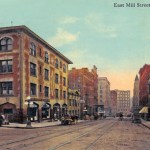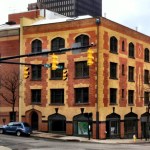- The Gothic Building, early 1900s
- The Gothic Building, 2013
By James Caprio
At the turn of the 20th century, Akron had grown into a bustling city. The Ohio & Erie Canal had brought an unprecedented amount of business to the city, including more manufacturing and financial institutions.The growth of these businesses brought more wealth to the city and, in turn, created a demand for upscale residential buildings. One of the gems that this demand created was the Gothic Building. The Gothic Building was designed by the well-known Akron architect Frank O. Weary. Weary was also responsible for the design of other buildings in Akron, including Buchtel Hall, the Carnegie Library, and the Glendale Cemetery Civil War Memorial Building. The Gothic Building was modeled after the Georgian Gothic Revival style, which was popular during the late 1700s and early 1800s. This design style features multi-color brick work, arched windows with contrasting trim colors, and asymmetrical designs. The Gothic Building was attached to the old Colonial Theatre, which was built in 1902 and razed in 1970. The Gothic not only served as a residence building, but it also housed numerous companies over the year. In the 1920s, the Gothic Building became the offices of the editorial “Akron Topics”, a popular publication discussing the current trends in Akron. The site later became home to Edfred’s Record Store in 1941 and All-Ohio Athletic Equipment in 1962. The Gothic has also housed a variety of other businesses since. In 2007, the Gothic Building was purchased by Tony Troppe and a group of private investors called the Gothic City Revival Group LLC. The Gothic in recent years has hosted numerous musicians as a venue and serves as the headquarters for Leadership Akron. The Gothic Building remains one of the finest buildings in downtown Akron today.


